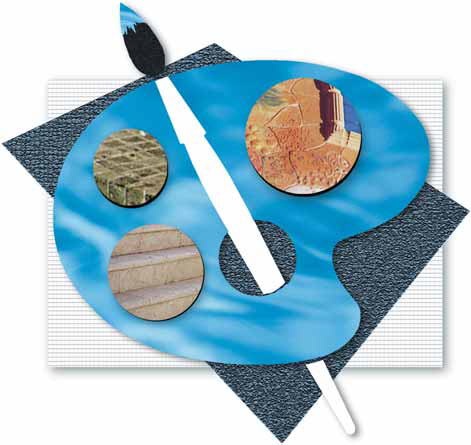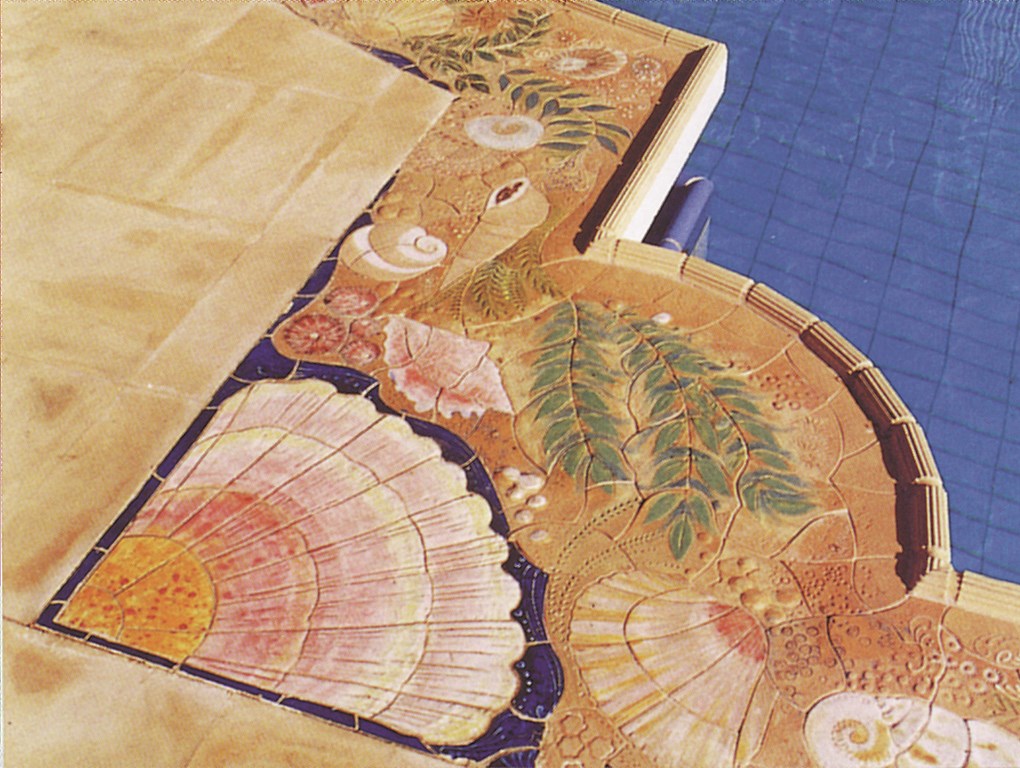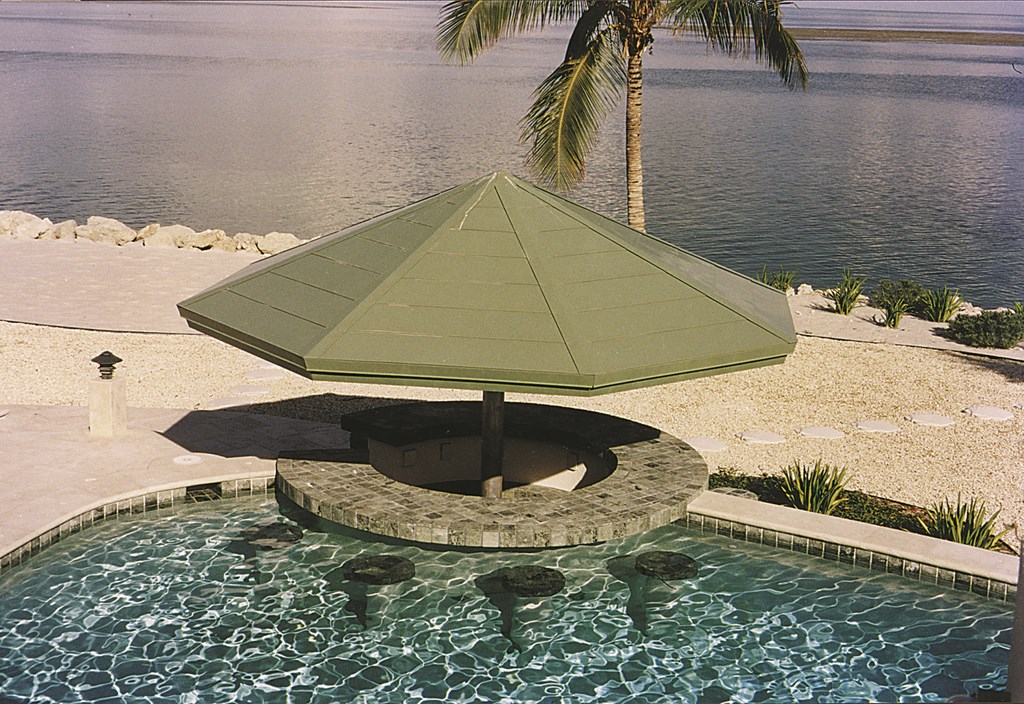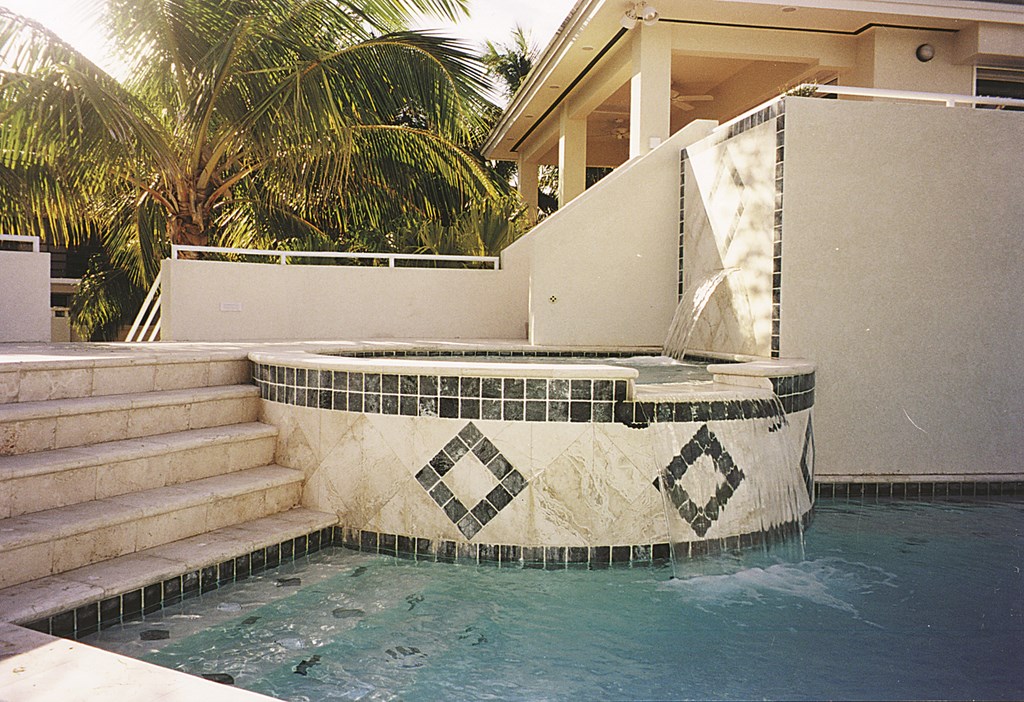Thriving in the Material World

There’s much to be said about this brave, new world of watershaping we’re in right now – and one of the things that’s most abundantly clear is that clients expect more these days: What was “good enough” before just won’t cut it, and to my way of thinking, that’s a very good thing!
One of the areas that most reflects this increase in expectations is the selection of the materials we use. More and more people I talk to around the country are now using things they wouldn’t even have considered just five years ago – things that can add tremendous value, interest, distinction and beauty to the end product.
When you open up to the world of possibilities available to each and every one of us in the trade, what you can achieve is limitless. From tile mosaics or new interior finishes to patio furnishings, stone, glass or even wood, you get into an area where each job becomes a form of personal artistic expression, both for you and your clients.
True, these materials sometimes drive up the price tag, but often the costs are not so outrageous. What’s more important is that by making an array of beautiful materials available, you empower clients to consider their watershapes in all-new ways – and to regard you in a more positive and elevated light.
ON THE INSIDE
Perhaps the most obvious place where the palette has grown in recent years is on the inside of our watershapes. Interior surfacing options have really exploded in recent years, taking what was once a “white only” marketplace and opening it up to all the colors of the rainbow.
For the longest time, white plaster ruled the roost. Beyond that, there were liners and there was paint. The 1970s saw the advent of colored plaster, and it’s funny now to think about how “cutting edge” a pool with dark blue, gray or black plaster seemed in those days.
Now, the whole area of interior finishes has opened up: different colors, several types of exposed aggregate finishes, pebble finishes – all pretty dazzling, especially when you get into custom blends and colored cements. And then there is a new wave of polished aggregates. We really do live in exciting times.
And let’s not forget the granddaddy of all interior finishes: tile. The ancient Romans used tile to line their pools and baths, and many of these installations have held up and are still beautiful more than 2,000 years later. That’s a roundabout way of making an important observation: Much of what goes on with materials is cyclical. Clients respond to design trends and the flavors of the season. Things get hot, cool off and then heat up again.
 The best materials will ride out these trends, improve and bounce back, and that’s certainly the case with ceramic tile. Just consider mosaics. Once the realm of the artisan, fantastic tile mosaics are now available as off-the-shelf designs or can easily be custom-supplied based on a photograph or some other image.
The best materials will ride out these trends, improve and bounce back, and that’s certainly the case with ceramic tile. Just consider mosaics. Once the realm of the artisan, fantastic tile mosaics are now available as off-the-shelf designs or can easily be custom-supplied based on a photograph or some other image.
Not too long ago, I did a project where my clients wanted something unusual in the bottom of their pool. They’d made a bundle in the tomato trade and wanted to pay homage to this most exalted of foodstuffs by way of a glass tile mosaic in the bottom of their pool. So that’s what they got. It wasn’t my choice of images, but they were thrilled – and the tile supplier made it all so easy.
On the other end of the scale, hand-made mosaics done by the true artisans are gaining in popularity as well. I work with an amazing local craftsperson who does absolutely stunning mosaics. If clients have an interest in a truly high-end touch, I’ll refer them to him. A good guy and a true artist, he typically blows my clients away, and I find that their view of me is elevated through my association with him.
Beyond mosaics, there’s been a virtual explosion in the available forms of ceramic tile. You’ll see vivid colors, unusual textures, lots of sizes and sheens – anything you can imagine and then some. And when you throw today’s glass tile into the mix, it gets even more amazing. There’s a mind-boggling richness in color and a subtlety of hues and textures on the market today.
I recently found a new line of products from a U.K. company called Craig Bragdy Design. They’ve been doing genuinely amazing things with textured tiles and three-dimensional tile shapes (see the image above for an exaqmple). They even have tiles that can be used as coping, and they make cornered tiles that have intricate patterns embossed on the surface. It’s exquisite stuff – and I didn’t even know it existed until just recently.
RAPT IN GLASS
Another example of the cyclical nature of product popularity and development can be found with glass block. Back in the 1970s, when we first started seeing glass block used in swimming pools, it was truly the cutting-edge material. I recall doing spas where the walls were mostly glass block: We’d back-light the glass and send the water over the side into the pool, and the effects were pretty impressive to everyone.
|
Simplicity and Elegance I have a theory that when it comes to achieving truly riveting designs, less can really be much more: Take a simple rectangular pool, line the interior with deep-blue tile and add coral around the edges or on the decking and what you’ve got looks fit for royalty. But it’s not all about going all the way: When I make use of the materials I describe in the accompanying text, I’ll often use small touches or accents to set off an element or draw interest to it. If I have a raised wall in a job, for example, I’ll always consider using some glass tile or a small mosaic, or capping it with tumbled marble, or using some small tile inlays. In this way, I can add million-dollar touches without breaking my clients’ bank accounts. I’ll also add small, simple touches to pathways or decks. Lots of time, all it takes is rummaging through a box of leftover tiles. Take it out back, bust the stuff up with a hammer and add pieces into the finish of a small area of decking. The point is, these touches truly impress clients by tying outdoor spaces together as integrated packages. That’s what good design is all about. – B.V.B. |
For years, we saw pools with all sorts of glass-block details, from inset rows of glass in raised walls to accents in adjoining structures. Then, for whatever reason, the trend faded away. Part of the decline had to do with problems with things like efflorescence in the grout, but more than anything I think we all just grew kind of tired of glass blocks. They became too popular for their own good!
But now, because of several new twists with the product, blocks are coming back in some applications. There are colored glass blocks, etched glass blocks with exquisite surface patterns, round blocks, frosted blocks. My friend Skip Phillips has created deck-top columns of radiused glass blocks and lit them from beneath for a dramatic effect. It’s like the whole genre has re-invented itself and is again on the cutting edge.
I’ve also started using acrylic in some jobs, and again this is not new. We’ve all seen underwater windows in pools or in displays at Seaworld and places like that, but when you get creative, there are other things that you can do with acrylic.
For example, I recently built a spa where I used a thick sheet of acrylic as the dam wall. I designed a rounded, bullnose detail on the top to provide a smooth flow of water spilling over it. And because the acrylic has no grout lines or seams of any kind, the glass is functionally invisible. The effect is that you can’t really tell what’s holding the water back. (It’s sort of like Moses parting the waters in the pool in a small-scale sequel to The Ten Commandments.)
I also use tempered glass in some jobs. In one case, I built a waterfeature in the artsy South Beach area of Miami and keyed the whole design to a dramatic 10-by-30-foot panel of 3/4-inch-thick glass in an elevated wall. The whole thing is backlit with fiberoptic lighting – pretty stunning, if I do say so myself.
FROM THE QUARRY
Another classic material that’s undergone a renaissance of sorts is marble.
Marble is typically associated with a formal look – fluted columns and classical statuary – but I’ve found that there’s really more to it than just that. We tend to think of marble as being really shiny and glossy, and make no mistake: That’s a gorgeous look, but there’s a lot more going on with this material these days.
I recently completed a job, for example, where I used tumbled verde marble details at the waterline instead of tile. I also used it on the tops of stools and to finish the top of a swim-up bar (see the photo just below). I combined those touches with the use of a material known as saturnia (another quarried stone in the marble family), and the results were outstanding. Very, very pretty.
I also did a job where all the walls of the pool were finished in marble (See the second photo below). It gave the project a uniquely Mediterranean feel – and all that marble made for a dramatic pool interior, believe me.
Natural coral is another material that’s readily available with its own set of unique qualities. Nowadays there are a great many coral deposits on dry land that are mined and sold for architectural uses. It tends to be white or cream in color, with lots of interesting fissures and swirls of brown or golden tones. You’ll also find pieces with interesting bits of shell fragments or fossils. I recently inlaid coral blocks on the tops of a pool’s steps and tied that detail to coral used in various places in the decking and patio area.
And let’s not forget real rock. In this era in which artificial rock has gotten so good, it’s easy to overlook the elegance and beauty that can be afforded by things like granite or limestone.
I’m currently working on the design of a large perimeter-overflow vessel where part of the pool is flush with the patio and the rest is raised two feet above that level. The vessel has a modern look and a trapezoidal design, and right now I’m in the process of working with the customer on the materials. If I have my way, the exterior of the riser wall will be finished in black absolute granite, which is about as black as black rock can get. If my recommendation sails, the finished product will be truly spectacular.
Black absolute granite is just one example. You also need to look at limestone, saturnia, travertine, Jerusalem stone, flagstone, slate, quartzite – the list goes on and on. There are also various volcanic rock materials, and vivid metamorphic rocks as well. Many of these are available in flat pieces for decking, or as boulders for rockwork and landscaping.
As mentioned above, artificial rocks also have come a long way in recent years. Various suppliers and local craftspeople offer products that are formed using molds taken from natural rocks. I won’t go into it here, but suffice it to say that this, too, represents another set of material options.
BROADENING THE PALETTE
As if all of this wasn’t enough, there are also materials available to us that most people wouldn’t immediately associate with water.
Wood, for example, is a material that you don’t immediately think of when designing a watershape. I hope that some of you have seen photos of a waterwheel that David Tisherman built in conjunction with a pool at the home of a Hollywood mogul. The wheel is made of wood, and there’s no problem at all with exposing it to water so long as you use a watertight finish. It’s an uncommon poolside material, but it can be used to great dramatic effect.
Not long ago, I completed a waterfront project where I extended a wooden deck out from the pool over the water using wooden planks and piers. I’ve also used elevated wooden walkways over small streams. The results have been so positive that I’m now trying to figure out a way to create a true pier extending into a naturalistic swimming pool. Why not?
The thing to remember is that these sorts of touches aren’t for every project. When used in creative and appropriate ways, however, an exotic color or an unusual tile or a wooden feature can yield results that are both visually arresting and aesthetically satisfying.
Take metal as a last example: I particularly like using stainless steel, and I’ve done some highly custom railing treatments with this material. I’ve also seen other designers use copper sheeting in modernistic waterfeatures. I guess my point is that there are no defined limits for what we can use or accomplish in our designs. A second point is that my clients seem happy to reward me for coming up with these unique materials used in unique ways.
None of this is to say that white plaster, blue ceramic tile and bullnose brick coping are bad things or are gone forever. The way things go, I wouldn’t be surprised by a “retro” movement that resuscitates the market for kidney-shaped pools – just as leopard-skin prints and platform shoes come back every decade or so. If the folks at Volkswagen could bring back the Beetle, I’m certain someone out there can strike paydirt with a design book filled with lazy Ls.
What’s so amazing to me in writing this column is that I’ve really only skipped lightly over the vast range of options that are available these days. You just need to go looking for them, strap on your thinking cap and present them to your clients in ways that fire their imaginations.
When you do, the creativity and value you can bring to the table have no bounds, know no trends and are subject only to your creativity. What a great place to be!
Brian Van Bower runs Aquatic Consultants, a design firm based in Miami, Fla., and is a co-founder of the Genesis 3 Design Group; dedicated to top-of-the-line performance in aquatic design and construction, this organization conducts schools for like-minded pool designers and builders. He can be reached at bvanbower@aol.com.












